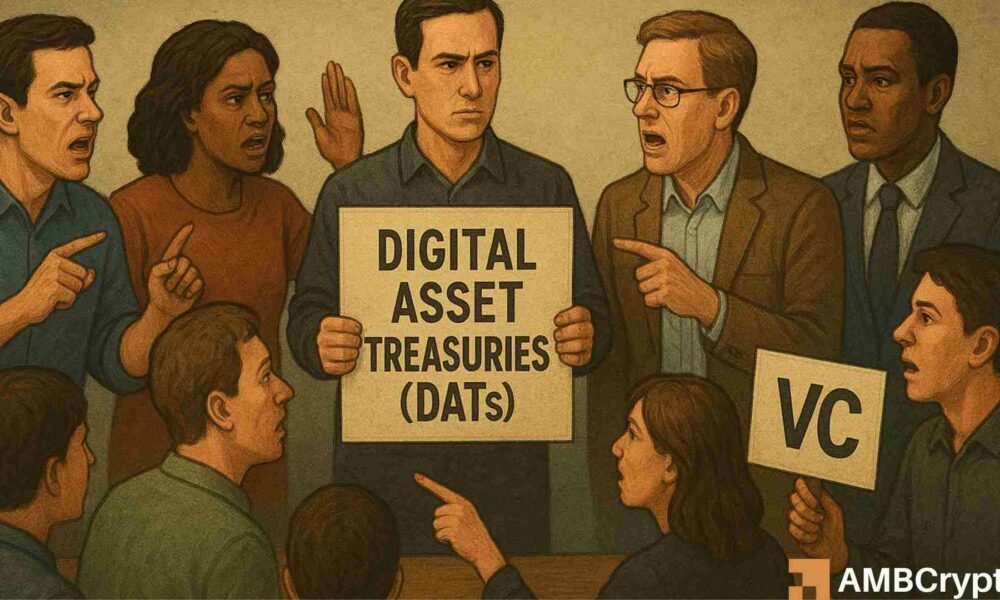The Current Landscape of Digital Asset Treasuries: Challenges and Future Prospects
Digital Asset Treasuries (DATs) have recently garnered attention as they face community backlash and market turmoil. Notably, concerns over alleged supply overhangs and links to venture capitalists (VCs) have created unease among crypto enthusiasts and investors. This article explores the current state of DATs, the implications of potential MSCI index exclusion, and what’s next for this sector amid a significant market sell-off.
Understanding the Backlash Against DATs
Interest in DATs has risen, particularly due to the ongoing market downturn and the looming threat of MSCI index exclusion. This deterioration was highlighted when SharpLink, an Ethereum-focused DAT, sold off $33.5 million in ETH. Such actions have sparked backlash, as many view DATs as contributing to a fragile market environment. Critics have labeled them “terrible, VC scams with overhangs,” a sentiment reflected in the hesitancy from community members. However, Haseeb Qureshi of Dragonfly Capital emphasizes that these generalizations might be unfounded, indicating that not all DATs are exerting net selling pressure on the market.
The Market Dynamics and Selling Pressure
SharpLink’s recent ETH sell-off, alongside potential pressures from other firms with declining market net asset values (mNAVs), has fueled skepticism regarding DATs’ integrity. While the perception of widespread selling persists, Qureshi points out that most DATs have not engaged in significant sales. Only a few smaller entities have offloaded assets, suggesting that selling pressures may be less influential on overall market performance than commonly assumed. This distinction is crucial, as it highlights the complex dynamics at play within the crypto treasury landscape.
VC Involvement and Community Skepticism
The involvement of major venture capital firms, like MultiCoin Capital, in the formation of substantial treasury entities such as Forward Industries has raised eyebrows among retail investors. The historical context of “VC tokens,” which have often been dumped on the retail market post-vesting, exacerbates suspicions regarding VC-led DATs. Investors remain alert to the risks associated with such connections, reinforcing negative perceptions even when major players haven’t actively sold their holdings.
The Impact of MSCI Index Review
The imminent MSCI review, expected by mid-January, stands to be pivotal for DATs and the broader crypto market. Analysts have expressed concerns that a reclassification of DATs by the MSCI index could further pressure the space, especially given the significant decline in crypto treasury values—over $45 billion lost, from $140 billion to $97 billion. David Bailey refers to this potential exclusion as “Operation ChokePoint 3.0,” criticizing its discriminatory nature against digital assets after previous inclusion.
Future Outlook for DATs
Looking ahead, the future of DATs may hinge on macroeconomic factors and the potential recovery of their mNAVs. Qureshi suggests that once improved, many DATs will likely start buying again, fostering positive sentiment. The sentiment shift could aid in stabilizing the market, provided that the community can address the concerns surrounding transparency and VC links. Maintaining this clarity will be critical for regaining investor trust and engaging a broader audience.
Conclusion
Digital Asset Treasuries are navigating a challenging landscape marked by community skepticism, market volatility, and the looming threat of MSCI index exclusion. While the narrative often leans towards negativity—fueled by notable sell-offs and VC connections—experts like Haseeb Qureshi offer a more nuanced view. The potential for mNAV recovery could act as a catalyst for rejuvenation in the sector. As this evolving story unfolds, the fate of DATswill likely continue to capture attention and influence broader market dynamics in the crypto space.


